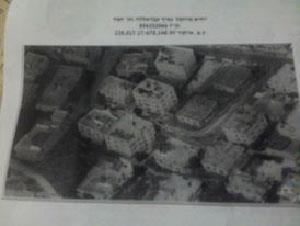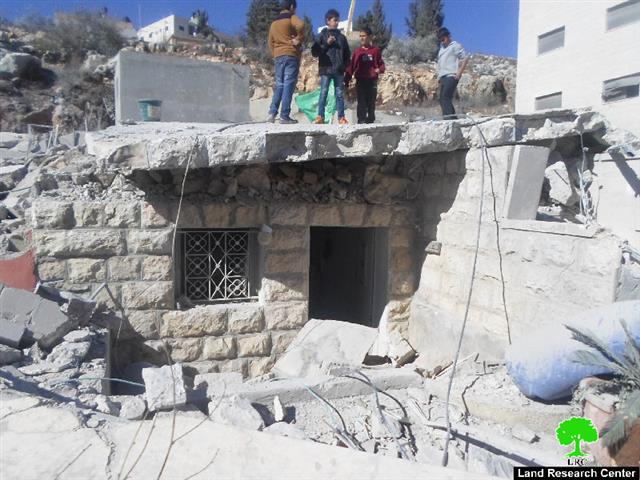Violation: detonating residences
Date: November 14, 2015
Victims: 18 families from the city
Details:
Collective punishment against Palestinians is a distinguished policy conducted by the Israeli Forces in the areas of the West Bank. The policy has been used since 1948 and is still conducted until today.
Israeli Forces on November 14, 2015 raided the city of Nablus and surrounded three residential blocs in preparation for detonating some residences belonging to alleged attackers who killed a colonist and his wife on the bypass road that leads to Itamar colony on October 2015.
According to Land Research Center’s field follow-up on the area, damages were reported as follows:
Destruction of an apartment and sabotage of 7 others in the area behind Al-Rawda College:
Israeli Forces at 1:30 after midnight surrounded the residence of detainee Karam Al-Masri (26), who was claimed to be one of the attackers. The residence (150m2) is home for Karam’s 6 member family; it is founded in a three story building.
Residents of the building were forcibly evacuated and left out in the cold; kids and women were traumatized. Shortly after, the house was detonated through explosives that were planted inside of it.
The building is now uninhabitable since the detonated house was located in the second floor; the structure is to fall down in anytime. Windows and power grids in the nearby were damaged due to the explosion.
Photos 1-6: the affected house
Blowing up a house in the area of Al-Dahya Al-Ulia:
To the west of Nablus, the Israeli Forces encircled the house of detainee Samir Kusa, which is of 130m2 in area and is composed of three floors. The first story belongs to the Samir where he lives with his 5 member family including 3 children.
The second floor is reported to be inhabited by Mahmoud Kusa (Samir’s brother) and his 3 member family including one child where the last floor is still under construction.
The Israeli Forces detonated the first story through explosives; second and third floors sustained cracks and are at risk of collapse due to the magnitude of the explosion.
Photos 7-13: the affected house of Samir Kusa
Demolition of two apartments in the neighborhood of Rujeib:
To the east of Nablus, the Israeli Forces encircled the house of detainee Yahya Hajj Mohammad (24). The building is composed of four floors (145m2 each). The first and second floors are inhabited by 11 members including 5 children.
The third floor is reported to be home for the detainee where the last floor is still under construction. The whole building belongs to Hiyam Al-Badoui (the detainee’s mother).
It should be marked that the Israeli Forces evacuated the residents of the building and left them out in the cold before detonating the house through explosives that were planted inside.
The building is now uninhabitable since the detonated house was located in the second floor; the structure is to fall down in anytime. Windows of three neighboring houses and power grids in the nearby were damaged due to the explosion.
Photos 14-18: the affected building of Yahya Hajj Mohammad
A collective punishment on Palestinians:
It is reported that three citizens were arrested in the alleged attack on a colonists and his wife two days after the attack took place, which is on October 03, 2015. On October 15, 2015 the Israeli occupation authorities served confiscation orders on the houses of the detained attackers; the orders gave a deadline of 72 hours only. The families objected to the order through the legal organization Hamoked. The objection was rejected and a plea was submitted in this regard on October 20, to reconsider the demolition order. As a result, the demolition was stopped by the court until the plea is considered.
Photo 19 & 20: the demolition order on Yahya’s residence
Israeli Supreme Court on November 12, 205 rejected the plea submitted in regard to the families’ houses and made a final demolition decision. The decision was carried out on November 14, 2015. The following table shows information about the targeted building in Nablus:
|
Name |
Location |
No. of affected residences |
Total aream2 |
Family |
Minors |
Remarks |
|
|
Total damage |
Partial damage |
||||||
|
Family of detainee Karam Al-Masri |
Behind Al-Rawda College |
1 |
9 |
450 |
12 |
4 |
Three story building. Each apt. is of 150m2 in area. Seven neighboring houses were damaged due to the explosion. |
|
Family of detainee Samir Kusa |
Al-Dahya Al-Ulia |
1 |
2 |
390 |
8 |
4 |
Three story building(130m2 each) |
|
Family of detainee Yahya Hajj Hamad |
Rujeib |
2 |
5 |
580 |
11 |
5 |
Four story building. Each apt. is of 145m2 in area. Three neighboring houses were damaged due to the explosion. |
|
Total |
4 |
16 |
1420 |
31 |
13 |
|
|
Source: Field observation- Department of Monitoring Israeli Violations- Land Research Center-2015
It should be marked that the order was issued in reference to the British Emergency Law for the year 1945, taking into consideration that this law was abolished. “Confiscation and demolition” according to article 119 of the law indicates that it is not allowed to re-construct in the demolition location. The body of the article is as follows:
Regulation 119 of the Defence (Emergency) Regulations, 1945
PART XII – MISCELLANEOUS PENAL PROVISIONS
Regulation 119 – Forfeiture and demolition of property, etc. 119.
(1) A Military Commander may by order direct the forfeiture to· the Government of Palestine of any house, structure, or land from which he has reason to suspect that any firearm has been illegally discharged, or any bomb, grenade or explosive or incendiary article illegally thrown, or of any house, structure or land situated in any area, town, village, quarter or street the inhabitants or some of the inhabitants of which he is satisfied have committed, or attempted to commit, or abetted the commission of, or been accessories after the fact to the commission of, any offence against these Regulations involving violence or intimidation or any Military Court offence ; and when any house, structure or land is forfeited as aforesaid, the Military Commander may destroy the house or the structure or anything on growing on the land.
(2) Members of His Majesty's forces or of the Police Force,· acting under the authority of the Military Commander may seize and occupy, without compensation, any property in any such area, town, village, quarter or street as is referred to in subregulation (1), after eviction without compensation, of the previous occupiers, if any.
Land Research Center LRC sees that demolitions contradict with all of the International conventions and Humanitarian laws including:
- Article 17 of the (1948) Universal Declaration of Human Rights stating: “Everyone has the right to own property alone as well as in association with others. No one shall be arbitrarily deprived of his property.”
- Section ‹G› of article 23 of the (1907) The Hague Conventions asserting: “In addition to the prohibitions provided by special Conventions, it is especially forbidden to destroy or seize the enemy's property, unless such destruction or seizure be imperatively demanded by the necessities of war.”
- Article 53 of the Geneva Fourth Convention (1948) declaring: “Any destruction by the Occupying Power of real or personal property belonging individually or collectively to private persons, or to the State, or to other public authorities, or to social or cooperative organizations, is prohibited, except where such destruction is rendered absolutely necessary by military operations.”
- Section 1, Article 11 of the International Covenant on Economic, Social and Cultural Rights (1966): “The States Parties to the present Covenant recognize the right of everyone to an adequate standard of living for himself and his family, including adequate food, clothing and housing, and to the continuous improvement of living conditions. The States Parties will take appropriate steps to ensure the realization of this right, recognizing to this effect the essential importance of international co-operation based on free consent."
Prepared by
The Land Research Center
LRC

































